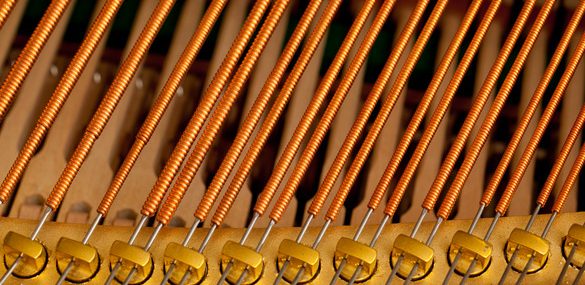Thanks to the Industrial Revolution, we live in a world where everything can be made faster, easier, cheaper, etc. But speeding processes up isn’t always a good thing.
In the piano industry, you have two choices when investing in a new instrument: uprights or grands. As a manufacturer, with that choice made, the pieces can easily be manufactured by an automated process, and assembled using mass production processes.
But there is a difference between these mass produced pianos, and one that is assembled by hand. Yes, there are still companies that do it the old fashioned way. And it can be a big difference in sound. Is it worth the difference in cost?
Let’s start with one of the main differences that has a lasting impact – the piano harp.
The piano harp is a large, cast iron plate that gives a piano its structure. This is the form that holds string tension and must take over 20,000 pounds of tension to create sound. This harp is made from a single cast, which can be made in one of two ways.
The first is wet sand casting. A template is made and is pressed into sand. Once removed, molten iron is poured into the mold, allowed to cool and cure for several months. This creates strength and alignment, both of which are necessary to ensure quality sound from an instrument.
The other is vacuum casting. A mold is created of the piano harp intended to use in production. It’s lined with a special membrane, a vacuum sucks the molten iron into the layer, and the product is finished in record time. These harps require no seasoning, need less finishing work, and can be put into assembly line processing in no time. Meaning the number of pianos produced increases exponentially.
Because of the way they are produced, vacuum piano harps are thinner, and create what some say is a tinier sound. Wet sand casting produces a thicker piano harp, and is refined by hand until it produces the quality the builder is looking for.
This, of course, creates a more expensive instrument. But knowing every item on the piano was touched, strung, applied, and built in with a one-person, one-product process means your piano will be the best it can be.
That doesn’t make mass produced pianos bad; instead, it gives you more flexibility with what you’re willing to pay and bring into your home.
A handmade piano will have more value over the life of the piano. It may give you many more years of play before it requires extensive repair or restoration. It may be easier to maintain over the decades.
But if your goal is to bring the love of music into your home today, with the thought of upgrading as you or your child progresses with your desire for playing, a mass produced piano may be your perfect choice.
What piano is best for you? Stop by today and we’ll help you select the perfect piano for your home.


